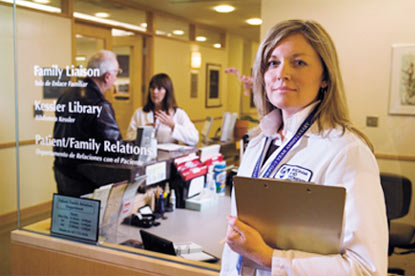Study Finds BarCodes Helpful in Reducing Medication Errors
As questions about how to improve patient safety continue, a new study by Brigham and Women's Hospital (BWH) suggests that barcodes may be part of the answer.
From accidental overdoses to allergic reactions, errors in the transcription and distribution of medication can have serious and, in some cases, lethal consequences for patients. As a result, providers have long sought ways to improve patient safety. Reducing medication errors helps reduce costs and, ultimately, improves the level of care patients receive.
New research findings from Brigham and Women’s Hospital (BWH) show that using both barcode technology and electronic medication administration record (eMAR) together substantially reduces transcription and medication administration errors as well as related potential drug-related adverse events. The research appears in the May 6, 2010 issue of the New England Journal of Medicine and was funded by the HHS’ Agency for Healthcare Research and Quality.
Bar-code eMAR technology ensures that the correct medication is administered in the correct dose at the correct time to the correct patients. When nurses use this technology, medication orders appear electronically in a patient’s chart after pharmacist approval. The technology also alerts nurses electronically if a patient’s medication is overdue. Before administering medication, nurses are required to scan the bar codes on the patient’s wristband and then on the medication. If the two don’t match the approved medication order or it is not time for the patient’s next dose, a warning is issued.
Researchers compared 6,723 medication administrations on patient units that did not have bar-code eMAR and 7,318 medication administrations on patient units that did. The implementation of bar coding linked to an eMAR was associated with a 41 percent reduction in non-timing administration errors and a 51 percent reduction in potential drug-related adverse events from these errors.
Errors in the timing of medication administration fell by 27 percent. Transcription errors and their associated potential drug-related adverse events were essentially eliminated.
“Our study shows that this set of technology can make the delivery of hospital care safer. However, hospitals need the right set of resources and human talent to deploy this technology successfully so more research is needed to identify ways to implement it in the most cost-effective way,” said lead study author Eric G. Poon, M.D., M.P.H. of Brigham and Women’s Hospital, Boston.
“Medication errors in hospitals are a very serious issue and can often lead to patient harm,” said AHRQ Director Carolyn M. Clancy, M.D. “The good news from this study is that using bar-code technology and an electronic medication administration record together can be an important intervention to achieve medication safety.”
The findings have important implications because bar-code eMAR technology is being considered as a 2013 criterion for “meaningful use” of health information technology under the American Recovery and Reinvestment Act of 2009.
The authors also suggest that decision support embedded within computerized physician-order entry (CPOE) and bar-code eMAR technology would play complementary roles in medication safety efforts. While CPOE is more likely to prevent errors that result from bad judgment, insufficient knowledge, or incomplete clinical information when choosing a therapeutic plan, bar-code eMAR technology is more likely to prevent errors associated with memory lapses or mental slips in executing a therapeutic plan.
Medication errors come in different forms, though transcription and dosage related errors are common. Poor handwriting by doctors has often been cited as the root cause for transcription errors. According to the Agency for Healthcare Research and Quality, poor penmanship is responsible for 6 percent of all hospital medication errors. A study conducted in the 1970s found that nearly one-third of all physicians' handwriting was illegible. More recent studies have cited an improvement, but still find a significant number of doctors have handwriting that is only marginally legible.
Medication errors can also cause allergic reactions or dangerous drug interactions that can have serious consequences for the patient. One often overlooked aspect of medication errors is that when the patient is given the incorrect drug or a lower dosage, they are not receiving proper treatment for their initial condition, prolonging their hospital stay and increasing costs.

